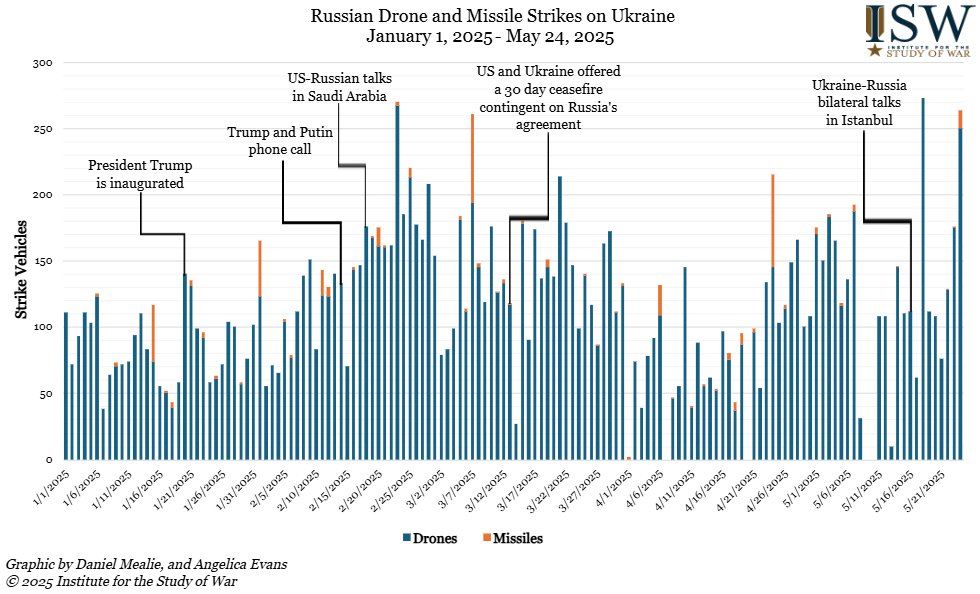Russian President Vladimir Putin is leveraging long-range strikes against Ukrainian cities, aggressive rhetorical campaigns, and excessive pessimism in the West about the battlefield situation in Ukraine in a multi-pronged effort to degrade Ukrainian morale and convince the West that a Russian victory in Ukraine is inevitable and that supporting Ukraine is futile. Russian forces have intensified long-range strikes against Ukraine over the last eight months and have conducted seven of the largest drone and missile strikes during the war to date since January 2025. Russian officials are currently inundating the information space with calls for Ukraine to make concessions on its sovereignty and territorial integrity, although most of these statements are consistent with long-standing Russian war demands and in fact demonstrate that Russia's demands have not changed over the last three years of war. These demands ignore the fact that the battlefield situation has shifted dramatically since early 2022, and that three years of manpower and materiel losses have significantly degraded the Russian military's ability to conquer Ukraine. Russian advances have significantly slowed as Russian forces continue to suffer personnel losses and increasingly rely on poorly trained and equipped infantry to make gains. Putin remains deeply committed to distracting from the realities of the battlefield situation, however, as bringing about the cessation of Western military assistance to Ukraine is Russia's only real hope of winning this war.
Russian forces conducted the largest combined drone and missile strike of the war against Ukraine on the night of May 24 to 25. The Ukrainian Air Force reported on May 25 that Russian forces launched nine Iskander-M and Kn-23 ballistic missiles from Kursk Oblast, 55 Kh-101 and Kalibr cruise missiles from Saratov Oblast and the Black Sea, one Kh-22 cruise missile from the airspace over the Black Sea, and four Kh-59/69 cruise missiles from an unspecified area of Russia and 298 Shahed and decoy drones from the direction of Bryansk, Kursk, and Oryol cities; Millerovo, Rostov Oblast; and Primorsko-Akhtarsk, Krasnodar Krai. The Ukrainian Air Force reported that Ukrainian forces shot down 45 cruise missiles and that two Kh-59/69 missiles were "lost in location." The Ukrainian Air Force reported that Ukraine shot down 139 drones and that 127 drones were "lost." Ukrainian officials reported that the Russian strike primarily targeted Kyiv and Chernihiv oblasts and also targeted Zhytomyr, Khmelnytskyi, Ternopil, Sumy, Odesa, Poltava, Dnipropetrovsk, Mykolaiv, Kharkiv, and Cherkasy oblasts. Ukrainian officials reported that the strikes killed at least 12 people and injured up to 60 people.
Ukrainian sources noted on May 25 that Russian forces are increasingly launching missiles from occupied Crimea after using missiles less frequently over the last five months. Ukrainian Main Directorate of Intelligence (GUR) Spokesperson Andriy Chernyak reported that Russian forces have launched more than 50 missiles from mobile missile systems in occupied Crimea since January 1, 2025. Chernyak stated that Ukrainian Forces struggle to strike the mobile missile launch systems since Russian forces can deploy the systems in 20 minutes and quickly break down and move the systems after a launch. Experts familiar with the topic reported that Russian forces have been launching Iskander ballistic missiles, Oniks supersonic anti-ship cruise missiles, and Zircon hypersonic cruise missiles from Crimea. ISW assessed on May 24 that Russian forces have used fewer cruise missiles in strike packages since January 2025, likely due to increased reliance on cheaper long-range drones. The May 24 to 25 overnight combined strike indicates that Russia may be stockpiling cruise missiles in order to conduct large-scale combined strikes against multiple areas of Ukraine at will. Russia may also be using highly varied strike packages in order to confuse Ukrainian forces and prevent Ukrainian forces from conducting consistently effective air defense.
Key Takeaways:
- Russian President Vladimir Putin is leveraging long-range strikes against Ukrainian cities, aggressive rhetorical campaigns, and excessive pessimism in the West about the battlefield situation in Ukraine in a multi-pronged effort to degrade Ukrainian morale and convince the West that a Russian victory in Ukraine is inevitable and that supporting Ukraine is futile.
- Russian forces conducted the largest combined drone and missile strike of the war against Ukraine on the night of May 24 to 25.
- Russian Security Council Deputy Chairperson Dmitry Medvedev suggested that Russia will occupy most of Ukraine if the West continues to aid Ukraine.
- The Kremlin is attempting to leverage large strike packages and increasingly aggressive rhetorical efforts to distract from the Russian military's poor performance during this current stage of the war.
- Russian forces have eliminated the Ukrainian pocket southwest of Toretsk after a four-month-long offensive operation to level the frontline south and southwest of Kostyantynivka in order to set conditions to advance towards the settlement.
- Russian forces would need roughly a century to seize Medvedev's proposed "buffer zone" at their current rate of advance at the cost of nearly 50 million casualties at current loss rates.
- The Kremlin is also using its bilateral engagements with Ukraine and the United States to maintain the appearance of being interested in peace and delay Western discussion of additional aid to Ukraine.
- Russia's only real hope of winning this war is to convince the West to abandon Ukraine.
- Russian forces recently advanced in Kursk Oblast and near Kharkiv, Chasiv Yar, and Toretsk.
| 




 [국방부] 군인 사칭 의심신고, 국방헬프콜 1303
[국방부] 군인 사칭 의심신고, 국방헬프콜 1303
 [ISW] 러시아의 공세 캠페인 평가, 2025년 5월 24일
[ISW] 러시아의 공세 캠페인 평가, 2025년 5월 24일